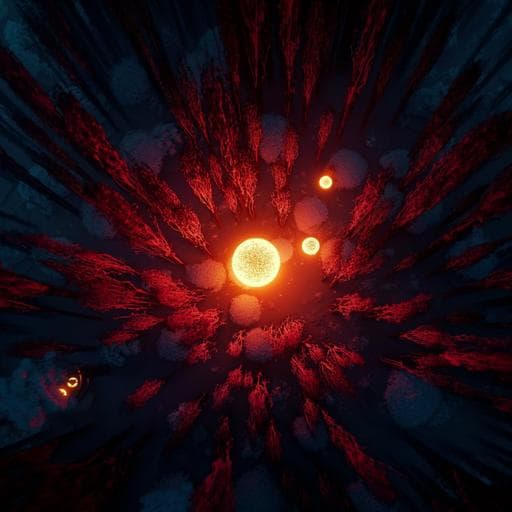
Computer Science
Drone Swarm Strategy for the Detection and Tracking of Occluded Targets in Complex Environments
R. J. A. A. Nathan, I. Kurmi, et al.
This innovative research conducted by Rakesh John Amala Arokia Nathan, Indrajit Kurmi, and Oliver Bimber presents an adaptive real-time particle swarm optimization strategy for drone swarms. The study reveals a significant improvement in target detection and tracking within densely forested areas, achieving up to 72% visibility in just 14 seconds, far surpassing traditional methods.
~3 min • Beginner • English
Introduction
The study addresses the challenge of detecting and tracking targets that are partially or fully occluded by vegetation, a key obstacle for search and rescue and surveillance in forests and disaster sites. While drone swarms can collaboratively achieve tasks beyond single drones, existing sampling strategies for airborne optical sectioning (AOS)—an optical synthetic aperture (SA) imaging technique—have relied on blind, predefined waypoints with either sequential or parallel sampling. These methods do not adapt to local occlusion variability or exploit oblique views that increase a target’s projected footprint. The authors propose an adaptive PSO-driven swarm strategy that dynamically explores and exploits local viewing conditions (sparser canopy gaps and oblique angles) to maximize target visibility in real time, even under randomness and non-stationarity of the objective caused by occlusion and target motion.
Literature Review
Prior work on aerial swarms spans surveillance, mapping, communications, tracking, inspection, construction, and logistics, using centralized or decentralized control and hand-crafted or algorithmically designed (heuristic, evolutionary, learning-based) behaviors. Meta-heuristics such as PSO are popular due to computational efficiency and robustness in non-Markovian, credit-assignment-heavy settings. Synthetic aperture sensing has broad applications (radar, radio telescopes, microscopy, sonar, ultrasound, LiDAR, imaging). The authors’ previous AOS research demonstrated through-foliage imaging by integrating registered images from different viewpoints to simulate a wide aperture, enabling enhanced detection and classification in integral images. Earlier AOS sampling used (i) sequential single-drone sampling along waypoints and (ii) parallel sampling via rigid camera arrays. Sequential sampling is slow and prone to motion blur; arrays are cumbersome, limit SA size, and often undersample. Crucially, neither approach adapts to local occlusion density or view obliqueness due to complex, random scene structure that is hard to model or reconstruct in real time. Statistical models described visibility improvements for uniform occlusion with increasing images, but adaptive strategies exploiting local sparsity were not realized. This gap motivates an adaptive swarm with PSO tailored to AOS.
Methodology
The approach integrates a PSO variant with AOS imaging for autonomous swarm sampling. Classical PSO biases toward historical particle/global bests is unsuitable because the objective (visibility) is random, time-varying, non-smooth, and non-differentiable; re-sampling the same location yields no new visibility. The proposed PSO emphasizes exploration and contemporaneous optimization: (1) swarm behavior is constrained to current time with random local explorations biased toward a temporal global leader (best current sample) while enforcing a minimal sampling distance defining SA properties; (2) the objective is conditionally integrated, fusing both parallel samples (current time) and sequential samples (prior times) only if they improve visibility and have field-of-view overlap; (3) if nothing is found, the swarm biases to a default linear scanning pattern orthogonal to motion for maximal coverage. Algorithmic loop: at each iteration t, if the objective O(best) is below a threshold T (no reliable target), drones assume a linear formation with spacing s ≥ c4 and move at scanning speed c3 along direction SD (toward last known/assumed target direction), with divergence speed c5 toward the default pattern if a previously detected target is lost. If a potential target is detected, images from all drones at time t are registered to each candidate reference perspective; the integral with maximum objective defines I_best and P_best. Past images are integrated into I_best only if they further improve O and overlap in fov; recent images can be removed if doing so improves O. Velocities for the next step combine cognitive (c1 random refinement) and social (c2 attraction to P_best) components, constrained by a minimal horizontal sampling distance c4 (enforced via Rutherford scattering) to avoid oversampling and to maintain SA geometry. Default scan direction SD and speed c3 are updated using the most recent target position and motion estimates, ensuring swarm speed exceeds target speed. Collision avoidance is achieved by assigning uniform altitude offsets Δh across drones so neighboring drones are vertically separated; this minimally impacts spatial sampling resolution compared to pose errors and integration, while preventing drones from appearing in others’ views. Formulas relate field of view, altitude differences, coverage, and sampling loss ratios, with practical parameters showing small resolution loss. Objective function: apply Reed–Xiaoli anomaly detection to RGB and thermal bands of current images to identify abnormal pixels; after thresholding (≈99.98%), integrate masked anomalies across candidate reference views, select the reference producing the highest objective, then conditionally integrate prior time-step images that improve O. The objective score is the contour size of the largest connected component (blob) among abnormal pixels (via raster chain tree), correlating with target visibility and supporting position estimation via blob centroid. Hyper-parameters: c1 (cognitive), c2 (social) with constraints c1 ≤ c2 and c1 + c2 ≤ c4; c3 (default scanning sampling rate/speed), c4 (minimal horizontal sampling distance, set above target’s motion during iteration), c5 (divergence smoothness 0..1). After convergence, the configuration approximates a circle-packing arrangement within the SA; SA diameter a relates to c4 via the packing number r_n for n circles. Simulation and implementation: a WebGL-based procedural forest (ProcTree) generated 512×512 RGB+thermal aerial images (fov = 50°), with tree parameters for broadleaf species and densities of 300/400/500 trees/ha over a 1 ha area; cameras looked nadir. A centralized implementation on a consumer PC achieved average processing times of ~96 ms per iteration for current parallel samples and ~30 ms per image for sequential samples; example with n=10 and up to 3 prior steps processed ~40 images in ~1.86 s per iteration. Partial decentralization and GPU acceleration can further speed up processing. All experiments standardized drone ground speed (10 m/s) and compared sequential single-drone, parallel camera-array, and PSO-guided swarms (n=3,5,10).
Key Findings
- Adaptive PSO swarm sampling achieved a maximum target visibility (MTV) of 72% within 14 s by converging over sparse canopy gaps and favoring oblique views, outperforming blind strategies.
- Blind sequential brute-force sampling reached 51% MTV but required 75 s; blind parallel sampling was fast but attained only 19% MTV in 3 s.
- Swarm size effect: larger swarms improved visibility and coverage. Reported MTVs: n=10 → 72%; n=5 → 35%; n=3 → 22% (300 trees/ha).
- Forest density effect: higher occlusion reduced visibility. MTV decreased from 72% at 300 trees/ha to 42% at 400 trees/ha and 31% at 500 trees/ha.
- Moving target tracking (walking person): average estimation errors were 0.59 m in position, 0.09 m/s in speed, and 9.21° in direction. Visibility dipped during motion when sequential overlap was insufficient and rose when the target stopped.
- Swarm converged to distances that increased view obliqueness rather than directly overhead, and combined parallel and sequential samples when beneficial.
- Collision avoidance via altitude offsets had minimal impact on spatial sampling resolution; dominant degradation stems from pose estimation errors rather than altitude differences.
- Performance: adaptive swarm reached ≥50% visibility roughly 12× faster than blind sequential sampling in comparable conditions.
Discussion
The findings demonstrate that adaptive PSO-driven swarms effectively address the challenge of detecting occluded targets by autonomously sampling viewpoints that minimize occlusion and maximize oblique target views, thereby increasing the target’s projected footprint and visibility. Unlike blind sequential or parallel approaches, the PSO integrates both parallel (current) and sequential (past) samples conditionally, exploiting moments and locations of lower occlusion. A wider SA and denser sampling afforded by larger swarms further boosts visibility and coverage. The statistical visibility model for uniform occlusion predicts geometric improvement with more samples and hard upper bounds, but adaptive sampling in non-uniform occlusion outperforms such bounds by locally minimizing effective occlusion per sample. For moving targets, visibility can drop when past projections do not overlap, since only parallel samples aid occlusion removal; visibility recovers when motion ceases or when overlap is re-established. The default linear scanning pattern provides efficient coverage and facilitates re-detection if the target is lost, guiding divergence toward the last known location. Overall, the approach yields faster, more reliable detections than blind strategies under identical constraints, highlighting the benefit of coupling PSO with an objective directly tied to through-foliage visibility.
Conclusion
The paper introduces an adaptive PSO-based swarm sampling strategy for airborne optical sectioning that detects and tracks targets through foliage by dynamically optimizing viewing conditions. It defines a robust objective function based on multispectral anomaly detection and blob contour size, conditionally integrates parallel and sequential samples, and employs simple altitude-based collision avoidance with minimal impact on integral image quality. Simulations show substantial gains over blind sequential and parallel methods in both speed and maximum visibility, with performance scaling positively with swarm size and negatively with occlusion density. Future work includes real-world multi-drone experiments, automatic and adaptive thresholding for outlier suppression, exploration of PSO variants and other swarm behaviors, improved collision avoidance to reduce minimal sampling distance, support for uneven terrain, and leveraging modern communications (e.g., 5G) and edge/GPU processing for scalable, partly decentralized implementations.
Limitations
The evaluation is simulation-based and omits real-world dynamics such as drone acceleration/deceleration, communication and transmission delays, and sensor imperfections (GPS imprecision beyond assumptions, camera stabilization, noise). Terrain is modeled as flat; forest models are procedural and simplified compared to real canopies. Moving targets can be lost in locally too-dense occlusion or if moving faster than the swarm can follow. The default scanning strategy is necessary when targets are not detected or are lost, which may miss targets if initial directions or occlusions are unfavorable. The PSO threshold T for outlier removal was selected based on representative target-absent samples and not adaptively learned. Collision avoidance uses simple altitude offsets; more sophisticated methods could reduce minimal sampling distance and improve responsiveness.
Related Publications
Explore these studies to deepen your understanding of the subject.







